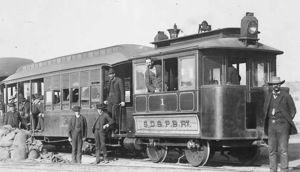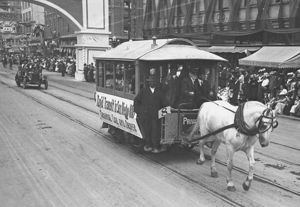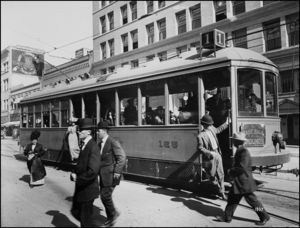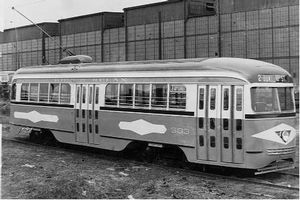San Diego Electric Railway
The San Diego Electric Railway (reporting mark SDER) was a standard gauge American electrified railway system founded by "sugar heir," developer, and entrepreneur John D. Spreckels in 1891 in order to provide mass transit services to the City of San Diego and its surrounding communities. Spreckels acquired all of the existing competing rail-based transit services (including horse-drawn, steam-driven, gasoline-powered, and cable car systems) and consolidated and expanded the lines into a unified network utilizing electric street cars. The railroad's original network consisted of five routes; at its peak in 1925 the system was comprised of sixteen separate routes. The company also engaged in limited freight handling from 1923 to 1929, primarily as an interchange with Spreckels' San Diego and Arizona Railway (SD&A). At its peak, the SDER's routes operated throughout the greater San Diego area over some 165 miles (266 kilometers) of track. Steadily-declining ridership (due in large part to the phenomenal rise in popularity of the automobile) ultimately led the company to discontinue all streetcar service in 1949, making San Diego the first major Southwestern city to convert to an all-bus transit system.
History
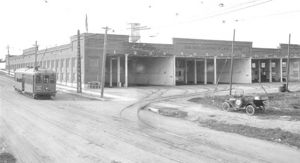
The streetcar barn in Mission Cliff Gardens, circa 1915. Constructed in 1913 to house surplus streetcars, the brick structure remained in existence until it was demolished in 1980.[1]
The railroad's original network consisted of five routes, delineated as follows:
- the Fifth Street and Logan Heights Lines;
- the First and "D" Streets Lines;
- the Depot Line;
- the Ferry Line; and
- the "K" Street Shuttle.
Before you can hope to get people to live anywhere...you must first of all show them that they can get there quickly, comfortably, and above all, cheaply. Transportation determines the flow of population.[2]
The company established additional operating divisions in response to increased traffic demands that led to the formation of new lines.
Forebears

A San Diego Cable Railway car decorated with red, white, and blue bunting carries a brass band in celebration of opening day: June 7, 1890.[3]
- July 3, 1886: The first horse-drawn open-air streetcar of the San Diego Street Car Company (SDSCC) (founded by Hamilton Story and Elisa Babcock) makes its run up 5th Street. The fare is five cents.
- November 9, 1887: The first electric-powered streetcar makes a test run on new tracks up Broadway to Kettner Boulevard and on to "Old Town."
- November 19, 1887: Electric streetcar service is inaugurated on the San Diego and Old Town Street Railway, making it the first electric railway on the west coast and the second in the country to use the "ground return" for electric current.
- 1888: The Electric Rapid Transit Company (ERTC) puts an electric streetcar into regular operation in San Diego.
- July 22, 1889: The San Diego Cable Railway (SDCR) is incorporated and takes over the failed ERTC.
- June 7, 1890: Opening day on the SDCR.
- September 9, 1890: The SDCR opens "Mission Cliff Gardens," a small recreation park (one of San Diego's first public recreation areas) overlooking Mission Valley as an end-of-the-line attraction for cable car patrons.
San Diego Electric Railway Company
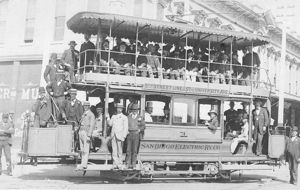
SDER #1, a double-decked streetcar, officially inaugurated SDERy passenger service on September 21, 1892.[4]
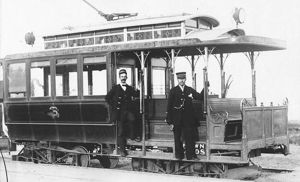
Car #6 on the University Heights / Mission Cliff Gardens Line, a cable car that has been converted to run on electricity.[5]
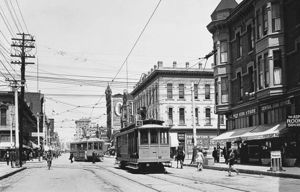
Looking south on Market Street toward 5th Avenue and San Diego's infamous "Stingaree District," circa 1904.[11]
- November 30, 1891: John D. Spreckels incorporates the San Diego Electric Railway Company.
- January 30, 1892: The SDERy purchases the SDSCC and the majority of its assets for $115,000; over the next few years the company will also acquire the competing Park Belt Line and the Ocean Beach Railroad. Plans are made to convert all existing lines to standard gauge traction, and ten single-truck, single-trolley, open platform wooden cars are subsequently purchased from the J. G. Brill and Company.
- September 19, 1892: Car #6 begins shake-down runs on the electrified portion of the line.
- September 21, 1892: Double-decked Car #1, the first such electrically operated car in the United States, makes the inaugural run with many of the City's notables aboard.
- October 15, 1892: The SDCR makes its last run, the company having declared bankruptcy earlier in the year.
- December 31, 1892: The line has grown to 16.70 miles (26.88 kilometers) of aggregated system track (12.21 miles, or 19.65 kilometers, of single electrified track with 4.49 miles, or 7.23 kilometers, for horse-drawn cars). Many new electrified lines will be constructed during the coming years.
- August 1895: The Citizens Traction Company (CTC) is formed and purchases the remains of the SDCR for $17,600, adapting the line to electric operation in order to compete with the SDERy.
- July 28, 1896: The first converted trolley car runs the entire length of the 4.7-mile (7.23-kilometer) long CTC line.
- February 12, 1897: Financial difficulties force the CTC goes into receivership.
- March 23, 1898: Elisa Babcock, as agent for the SDERy, buys the properties and franchises of the CTC for $19,000 plus "fees and costs." The track gauge is subsequently widened from 3'-6" (1,067 mm) to the standard gauge of 4'-8½" (1,435 mm)
- 1905: Spreckels builds a new power generating plant to accommodate the additional loads imposed by the expanding streetcar network.
- 1906: The Third Avenue Streetcar Line begins operation. The SDERy logs 798,152 car miles.
- 1907: The Third Avenue Streetcar Line is extended to the future community of Mission Hills, and is briefly renamed the Mission Hills Line.
- 1910: Spreckels forces a ballot initiative to amend his charter with the City of San Diego to give him more than 25 years on his leases to operate streetcar service. With this greater security he is able to acquire major loans for service expansion and infrastructure.
- 1911: The Imperial Avenue operating division is established in downtown. Spreckels builds a second power generating plant at Kettner Boulevard and "E" Street when the plant built in 1905 can no longer provide sufficient capacity.
- 1912: Twenty-four new Arts & Crafts Style "Class 1" streetcars are purchased by the SDERy.
- 1913: Construction of a new brick car barn located at Adams Avenue and Florida Street is completed.
- December 31, 1914: The SDERy owns 38.9 miles (62.6 kilometers) of single track and 22.4 miles (36.0 kilometers) of double track, for a total of 83.7 miles (134.7 kilometers) of "equivalent single track."
- 1915: The Panama-California Exposition in Balboa Park spurs the next phase of transportation growth. A new electric car line is constructed up 12th Street to the Park's entrance with 101 new cars from the St. Louis Car Company and the Adams Avenue operating division is established in Normal Heights. San Diego's original Victorian style train depot is demolished and replaced with a new Mission Revival Style Santa Fe depot building. The SDERy logs 3,521,571 car miles. A significant increase in the private ownership of automobiles results in lost revenues to private, unlicensed "Jitney Buses" that operated in violation of the SDERy's exclusive franchise agreement with the City.[13]
- 1916: The "Great Flood" washes out several rail lines. World War I increases the cost of railway construction materials by 50 to 150 percent.
- 1920: Spreckels announces plans to discontinue service on several rail lines to offset expenses, leading to the approval of "zone fares." The SDERy purchases new streetcars that require only one driver / conductor instead of two; older cars are retrofitted to reduce labor costs. Spreckels sells his power generating plants to the Consolidated Gas and Electric Company.
- 1921: The first motor bus goes into service operating between National City and Chula Vista. "Number One" has hard rubber tires, two-wheel mechanical brakes, a four-cylinder engine, and a plywood body.
- March 17, 1923: The SDERy begins its last major rail line expansion to Mission Beach ("Belmont Park"), Pacific Beach, and La Jolla. $2.5 million is spent on rails, Mission Revival Style terminals and substations, and Egyptian Revival Style stations. $800,000 is spent on the acquisition of 50 new cars. Construction is completed in 1925.
- December 18, 1923: Car #400, an all-steel model with a closed body and the first on the SDERy to feature a pantograph-type current collector, is delivered. All 50 pantograph-equipped cars would eventually have trolley poles installed at each end due to the pantographs' poor performance.
- 1925: The SDERy network maxes out at sixteen separate routes operating over 165 miles (266 kilometers) of track.
- 1930: Buses begin to replace street cars from Ocean Beach to La Jolla, and 222 new buses are added to the fleet. Ridership and revenue goes down but the SDERy is able to weather the economic downturn.
- 1935: The California Pacific International Exposition opens in Balboa Park without the need for expanded transit service.
- 1936: The SDERy orders 25 single-end Presidents' Conference Committee (PCC) cars from the St. Louis Car Company, becoming the first streetcar system in the United States to utilize streamlined units. The cars are designated as "Class 6." An order for 3 additional units is placed the following year.[14]
- 1941: World War II turns San Diego into a "boom town" once more. Defense related industries revitalize the City, as does the resultant influx of military personnel. Ridership on public transit increases 600 percent during the War years. Used transit vehicles are purchased from around the nation, and more electrical power is needed and substations are built (including one in the basement of the Spreckels Theatre Building on Broadway). The $2.5 million rail line built in the 1920s to the beaches is ripped out along with the elaborate stations and terminals and replaced with a bus line.
- 1942: The combined streetcar and bus lines carry 94 million people. Additional streetcars are brought in on loan from New York City, Salt Lake City, Utah and Wilkes-Barre, Pennsylvania to help keep up with demand.
- 1944: Combined ridership increases lead to more than 146 million trips.
- 1945: Cars #502 and #503 are painted red and blue (in lieu of the standard golden yellow) in support of the American Red Cross blood donation campaign.
- 1946: The SDERy begins to phase out streetcar lines and replace them with bus routes. By the following year, only three street car lines remained in operation.[15]
- July 26, 1948: The Western Transit Company purchases the SDERy for $5.5 million.
- August 1948: Thirteen new 45-passenger buses are placed into service.
- September 9, 1948: The Western Transit Company announces that the SDERy will henceforth be known as the San Diego Transit System (SDTS). A new emblem (consisting of a pair of wings with a shield in the center) and slogan, "Safety, Courtesy, Service," are adopted.
- January 13, 1949: The SDTS borrows $720,000 for the purchase of additional new buses, and makes an application to the State Public Utilities Commission (PUC) to discontinue streetcar service altogether.
- March 3, 1949: The PUC grants authority to the SDTS to abandon its remaining streetcar lines.
- March 27, 1949: A "farewell to the streetcars" excursion, operated over the remaining trackage, is sponsored by the Pacific Railroad Society of Los Angeles.
- April 23, 1949: Forty-five new General Motors buses (costing $20,000 each) parade down Broadway to mark the retirement of the street cars; free rides are offered during the procession.
- April 24, 1949: Rail service on the SDERy comes to an end at 5:45 a.m. as Car #446 pulls into the Adams Avenue car barn, making San Diego the first major city in the Southwestern United States to eliminate streetcars and convert to an all-bus transit system.
- May 23, 1949: Work crews begin removing the overhead trolley lines and tracks on the loop at downtown's Union Station.
- 1950: Seventeen of the PCC model cars are sold to the El Paso City Lines (EPCL) for service on the international loop between El Paso, Texas and the Mexican border town of Juarez, Mexico.
- 1952: Three more PCCs are sold to EPCL. All remaining "Class 5" cars and the three "service" cars are purchased by the Allied Salvage Company for scrap.
- August 1957: The 8 remaining PCCs are purchased by the San Diego Mill Supply Company. Car #508 is acquired by the Orange Empire Traction Company for display at its museum in Perris, California, and Car #528 is obtained by the Railway Historical Society of San Diego for preservation and exhibition.
- 1997: The San Diego Historic Site Board recognizes the three native "Class 1" streetcars with the official designation of San Diego Landmark #339.
Notes and references
- ↑ Hendrickson, p. 80
- ↑ Dodge, p. 18: J.D. Spreckels.
- ↑ Dodge, p. 20
- ↑ Dodge, p. 25
- ↑ Dodge, p. 30
- ↑ Dodge, p. 19
- ↑ Hanft, p. 13: Also called "motors," steam engines which operated on street railways were referred to as "dummies" as their boxed-in designed was intended to make them resemble enclosed horse cars and thus avoid scaring horses in the street.
- ↑ O'Connell, p. 79: The McKeen Railmotor was a 6-cylinder, self-propelled rail car. First unveiled in the United States in 1905, the McKeen was among the first units equipped with a gasoline-powered engine.
- ↑ Hollins, p. 300: The cars were often referred to as "Red Devils" owing to their Tuscan red paint scheme.
- ↑ Brooke, p. 337: "Ramona's Home" was, in fact the Casa de Estudillo, a historic adobe located in San Diego's "Old Town" that gained prominence by association with Helen Hunt Jackson's 1884 novel Ramona."
- ↑ Hendrickson, p. 12
- ↑ Engleman: This unit was subsequently sold to the City of El Paso as #1503.
- ↑ Holle, pp. 14-15: The Railway estimated that between 1915 and 1916 alone the loss amounted to more than $400,000.
- ↑ Dodge, p. 97
- ↑ The demise of some streetcar companies in the United States has been tied by some to the alleged "General Motors Streetcar Conspiracy," in which a consortium consisting of General Motors, Standard Oil, and others formed a front company, the National City Lines, in order to buy streetcar lines, shut them down, and replace them with buses. The plot of Touchstone Pictures' 1988 film Who Framed Roger Rabbit is loosely based on this theory.
